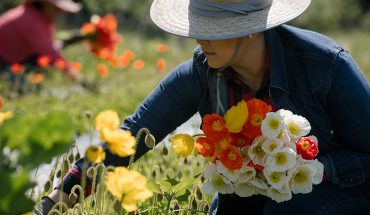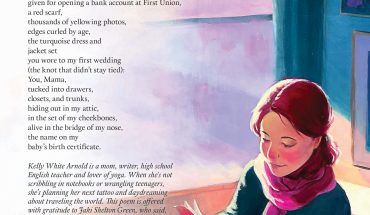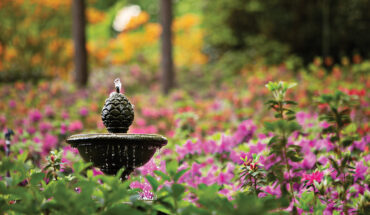Frank Harmon watches his garden fill with plantings—and memories
by Frank Harmon | illustration by Judy Harmon
Every spring a lawn care company tosses a flyer over my garden gate. They promise to make my lawn perfect by using herbicides and pesticides. But I think I’ll keep the lawn just as it is, with scatterings of chickweed, withered starflower stems, and the occasional snake skin.
I live in a small pink stucco house near N.C. State University. My wife Judy and I designed the house and garden in 1989. We broke ground on Valentine’s Day and moved in a year later. Then we planted the lawn.
We’d put down roots.
When we lived in England at one time, we fell in love with English gardens and English country houses. We also loved English lawns. Who wouldn’t? They were a tightly stretched blanket of grass as smooth as green velvet. I loved the stillness they brought to a busy landscape.
But we noticed that the English garden stopped at the door of the house. For our new home, we wanted it to be difficult to know where our garden ended and the house began.
So with visions of indoor-outdoor living, we set out to design a garden with a beautiful lawn. And a house that partnered with both.
The original meaning of the word paradise was “a walled garden.” So we built a wall around our future paradise and planted vines because we live near Hillsborough Street. College neighborhoods are busy places—especially on nights when the home team wins. Our vine-covered wall gave us an oasis.
Judy designed the garden as a series of outdoor “rooms” within a structure consisting of four 100-year-old oak trees, the wall, evergreen hedges, and, of course, the lawn. Like a grassy clearing in a forest, the lawn was the most important room in our garden.
It would be our outdoor living room.
Our children grew up playing on the lawn. Will set up croquet. Laura built miniature houses around the edges. Judy’s cousin and his then-five-year-old daughter liked to camp out on the lawn. Their tent glowed at night.
We held dinner parties on the lawn. On summer nights, Judy and I pulled cushions outside to go to sleep looking for meteors. In June, fireflies lit the lawn.
One Christmas Eve the weather was mild enough to sit outside and read. A few crickets sang, perhaps in memory of summer or of the first Christmas in a warmer land.
Whenever we returned home from a trip, we went to the garden first.
In 1996, Judy stood on the lawn in her pajamas at 3 a.m. as Hurricane Fran swept across Raleigh. The old trees above her swirled like ballerinas in the 90 mph winds.
On the night of 9/11, we sat out on the lawn looking up at a sky empty of airplanes.
In 2011, a tornado ripped through our neighborhood. There had been warnings on the radio all morning, but Judy wasn’t about to evacuate her beloved post in our sunroom and miss the storm. Fear had a hard time getting through to her. Around 2 p.m., a one-ton oak tree branch fell six inches from her window. She was thrilled.
Judy died, from metastatic breast cancer, in 2013. This is my seventh spring in the garden without her physical presence. Soon I’ll be on the lawn plucking out chickweed. Six-petaled starflowers will bloom in the grass.
Picking weeds out of grass is as good a way as any to reflect on the age-old struggle between nature and mankind. I’m not sure whose side I’m on. When we moved in, I thought I controlled the environment. Then I saw the plants and animals taking charge.
If I had worked at the minimum wage of $7.50 an hour all these years, we could have paved the lawn in marble for less than the cost of my labor. But then, a garden is like a marriage: You get out of it as much as you put into it.
Recently, my daughter and I were looking at photographs of the house and garden when it was freshly built, all spiffy lines and smooth walls. Now, thirty years later, the walls are entangled with vines and the edges are blurred.
“It’s much better,” Laura said.
We think we own the land. But after a while, it possesses us.




